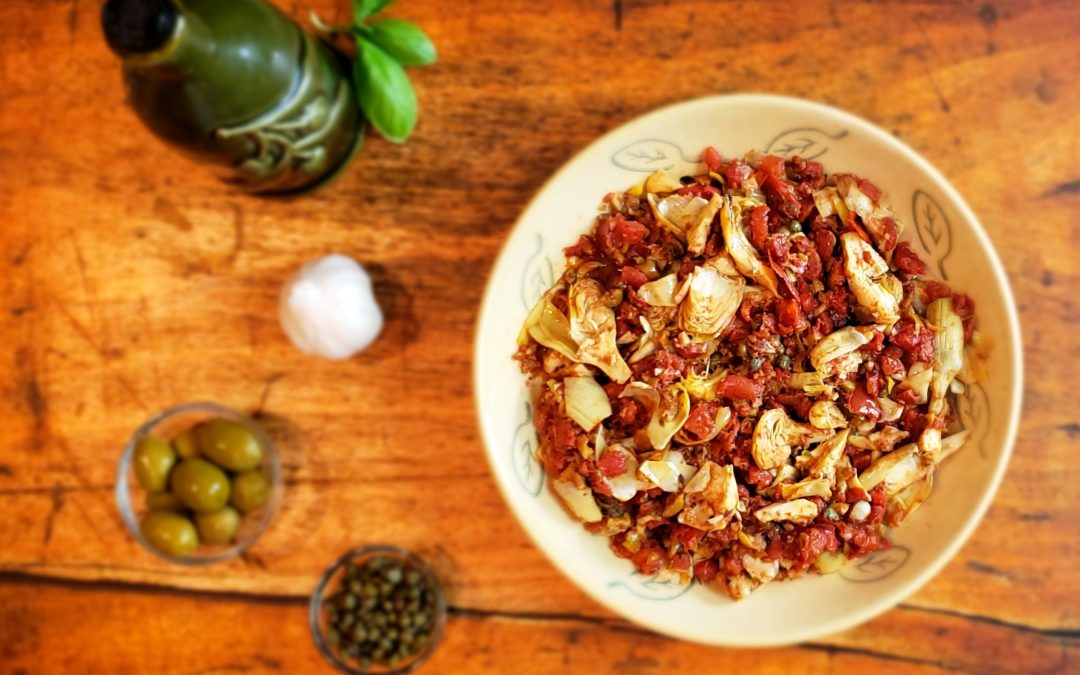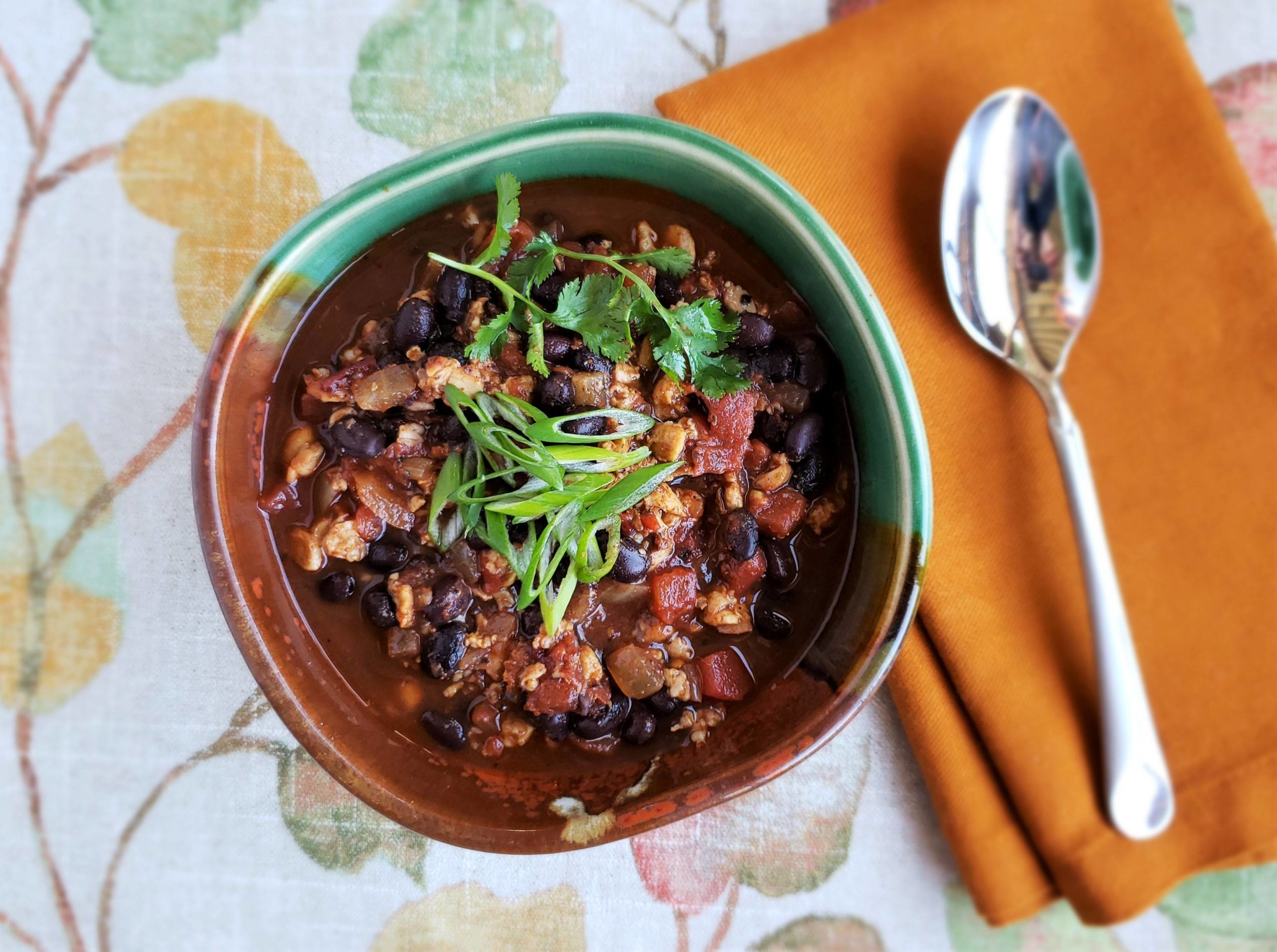Serves 6 as a complete meal with the pasta option A delicious mix of tangy, spicy and savory ingredients makes Puttanesca sauce (sugo alla puttanesca) a meal-time habit that can be made from your pantry. This popular Italian sauce commonly pairs with pasta but...

Corn, Tomato and Spinach Olive-Oil Galette
Corn, Tomato and Spinach Olive-Oil Galette
Olive-oil galette–Is it a tart? A pizza with a folded edge? A pie you eat for dinner?
It’s delicious no matter what you call it and, depending on your fillings, this olive-oil galette works for breakfast, lunch or dinner.
This quick, easy tart base can be made anytime with basic pantry ingredients since butter isn’t a primary ingredient. It works as a weekday meal but fits many occasions from picnics (simply eat slices by hand) to an elegant dinner with wine and real silverware.
Another advantage of adding an olive-oil galettes to your menu, other than sounding fancy French when you say “Galette” (a French word that actually sounds like it looks), is how easy it is to prepare for all eating styles from plant-only to eat everythingtarian.
Corn, Tomato and Spinach Olive-Oil Galette
Serves 12 as appetizer or 6-8 as a meal with a side
Crust Ingredients
2 cups all-purpose flour
½ teaspoon salt
½ cup fresh-grated parmesan
½ cup extra-virgin olive oil
½ cup plus 1-2 tablespoons ice water
Optional: Add 2 teaspoons toasted fennel seed or 1½ teaspoon toasted cumin seed
Galette Filling
2 teaspoons olive oil
12 ounces grape tomatoes, cut in half (about 2 ½ cups whole)
2 ears corn kernels (about 1¼ cup or 1 can drained and dried)
3 large garlic cloves, minced fine
¼ teaspoon red pepper flakes
1 teaspoon fresh thyme, minced (or ½ teaspoon dried thyme)
¼ teaspoon salt
10 ounces (about 8 cups) spinach
Optional: ½ cup fresh peas, blanched in salted water
4 eggs, prepare one for egg wash
¾ cup ricotta
1 cup grated gruyere (2.25 ounces), divided
Crust Steps:
- Add flour, salt, parmesan and any spices to a food processor; pulse until blended. Pour in olive oil while pulsing to mix into flour, you may need to break up large clumps. Then slowly pour in ½ cup cold water. Dough will start to pull away from sides and clump together, but if not, add a bit more water up to 2 tablespoons. Dough should feel smooth, moist but not tacky. Remove from food processor.
- Knead dough for about 30 seconds then form into a ball. Press the ball of dough into a disk and wrap in plastic wrap. Refrigerate for 30 minutes or up to 2 days maximum or freeze for later use.
Filling and Tart Steps:
- Heat a large skillet over medium-high heat, add olive oil. When oil is warm, add halved tomatoes, corn, garlic, pepper flakes, thyme and salt. Cook 8-10 minutes to reduce liquid. Add spinach, use tongs to toss to evenly wilt it—about 2 minutes. Remove from heat, let cool.
- Preheat oven to 375˚ Line a large baking sheet with parchment paper or coat one with olive oil. Place dough a floured counter, press the disc to flatten enough to roll out with a rolling pin. Sprinkle some flour on the dough or rolling pin and roll from the center towards the edges to create a circular, but imperfect, shape about 15” wide and ¼ inch thick—look for an even thickness overall. Pick up an edge and lift it to over the pin (think curtain rod) to lift the dough and place flat on the baking sheet.
- Mix together 3 eggs, add ricotta and all but ½ cup of gruyere, add cooled cooked ingredients, mix.
- Pour mix onto the center of the dough, spread it within 2 inches of edge. Fold dough border up over the filling either in small square sections or pleated sections. Brush the dough with egg wash.
- Bake 30 minutes, then top with the remaining ½ cup gruyere. Bake another 10 minutes or until crust is golden brown and center feels firm. Let cool before serving.
Serving options: Serve warm or at room temperature. Stores well for 3-4 days before crust begins to soften or break down.
Related Recipe: Here’s another recipe that could be a tart or pizza: https://eatwellacademy.com/corn-and-cremini-chickpea-cauliflower-pizza/

Artichoke Puttanesca–Forget its Saucy Reputation

The Sweet and Meaty Taste Science of Grilled Vegetables
“Let’s grill tonight” translates to “let’s eat meat tonight” in many backyard BBQs. It’s not surprising since grilled meat products create hundreds of complex aroma and flavor compounds. Grilled vegetables create less of these craveable compounds but develop delicious...

Chipotle and Black Bean Tempeh Chili
Making chili should be an easy, homemade treat, but chili competitions and throwdowns can make it feel like it should be Instagram-ble or complex. Typically meat is central to chili, yet this tempeh chili is a contest contender for a comforting, satisfying homecooked...

Michele Redmond
French-trained Chef, Registered Dietitian Nutritionist & Food Enjoyment Activist
It's about Making Food First
Get Eat Well Academy periodic updates on easy ways to choose and cook foods that satisfy your appetite, nurture your body and make eating well a pleasure.




 The pleasure of food, good health and well-being through simple habits for eating well and flexitarian low-key cooking.
The pleasure of food, good health and well-being through simple habits for eating well and flexitarian low-key cooking. 


 Swapping out a meat-based ingredient for a plant-based one is a balancing act of texture, taste qualities (like umami) and flavors from aromatic compounds. Particularly with liver—can you think of any plant that tastes or smells like it? Please let me know if you do.
Swapping out a meat-based ingredient for a plant-based one is a balancing act of texture, taste qualities (like umami) and flavors from aromatic compounds. Particularly with liver—can you think of any plant that tastes or smells like it? Please let me know if you do.
 Don’t let the nutrient-rich profile and French name fool you into thinking this is a fancy health food; ragout is your basic comfort food. A
Don’t let the nutrient-rich profile and French name fool you into thinking this is a fancy health food; ragout is your basic comfort food. A 



